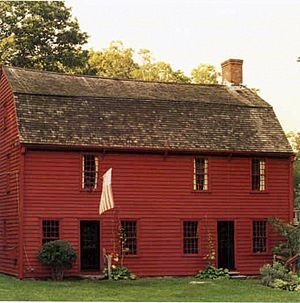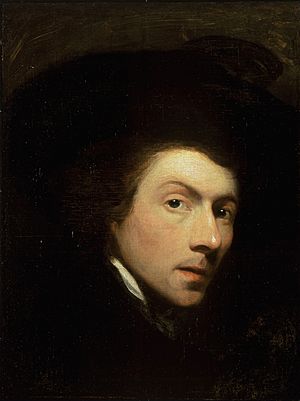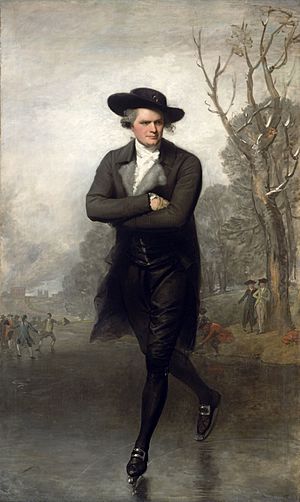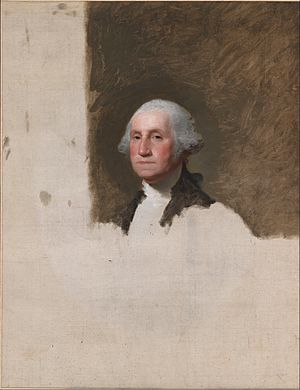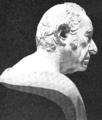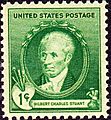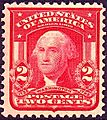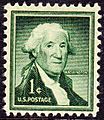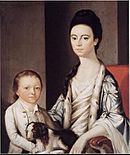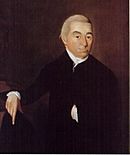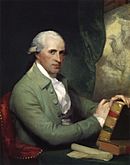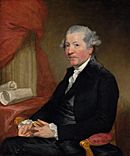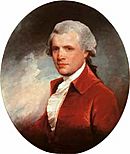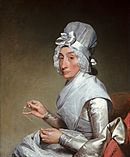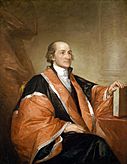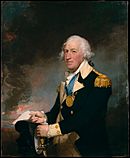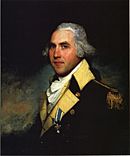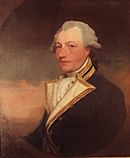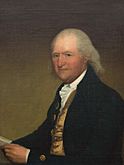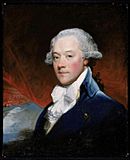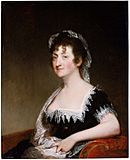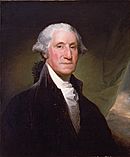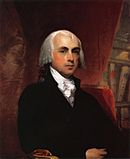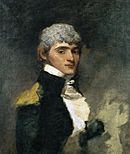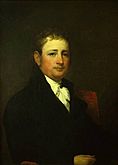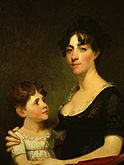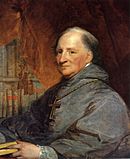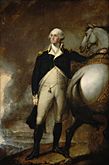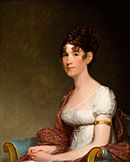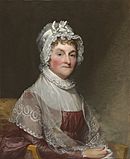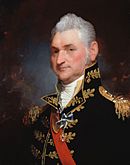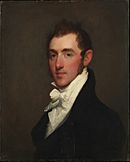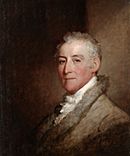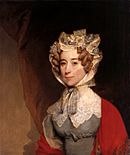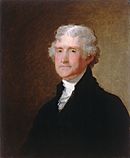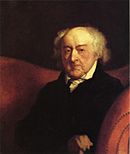Gilbert Stuart facts for kids
Quick facts for kids
Gilbert Stuart
|
|
|---|---|
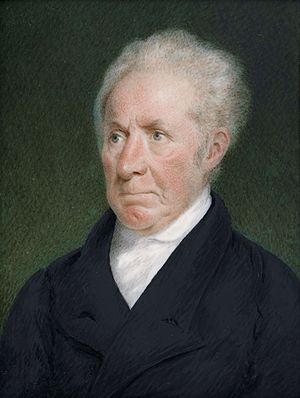
Stuart c. 1825 in a portrait by Sarah Goodridge
|
|
| Born |
Gilbert Charles Stewart
December 3, 1755 |
| Died | July 9, 1828 (aged 72) Boston, Massachusetts, U.S.
|
| Known for | Painting |
|
Notable work
|
George Washington (The Athenaeum Portrait) (1796) George Washington (Lansdowne portrait) (1796) George Washington (Vaughan portrait) (1795) The Skater (1782) Catherine Brass Yates (1794) John Adams (1824) |
Gilbert Charles Stuart (born Stewart; December 3, 1755 – July 9, 1828) was a famous American painter. He is known as one of America's best portrait artists.
His most famous painting is an unfinished portrait of George Washington. It was started in 1796 and is often called the Athenaeum Portrait. Stuart kept this painting and used it to make many copies for people who wanted them. The image of George Washington from this painting has been on the United States one-dollar bill for over 100 years. It has also appeared on many postage stamps.
Stuart painted more than 1,000 people during his life. This includes the first six Presidents of the United States. You can see his artwork in art museums across the United States and the United Kingdom. Some of these museums include the Metropolitan Museum of Art in New York City and the National Gallery of Art in Washington, D.C..
Contents
Gilbert Stuart's Life Story
Early Years
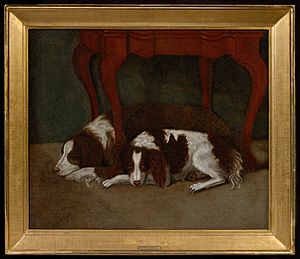
Gilbert Stuart was born on December 3, 1755. His birthplace was Saunderstown, a small village in North Kingstown, Rhode Island. He was the third child of Gilbert Stuart, who worked in the snuff-making business. His mother, Elizabeth Anthony Stuart, came from a well-known family.
When Stuart was six, his family moved to Newport, Rhode Island. There, his father worked as a merchant. It was in Newport that Gilbert first showed his talent for painting. In 1770, he met Cosmo Alexander, a Scottish artist who visited the colonies. Alexander became Stuart's art teacher.
Under Alexander's guidance, Stuart painted Dr. Hunter's Spaniels when he was just 14. This painting is still displayed today at the Hunter House Mansion in Newport. In 1771, Stuart went to Scotland with Alexander to continue his studies. Sadly, Alexander died in Edinburgh a year later. Stuart tried to make a living as a painter but found it difficult, so he returned to Newport in 1773.
Time in England and Ireland
The American Revolution began, making it hard for Stuart to find work as a portrait artist. Even though he supported the American cause, he moved to England in 1775. He followed the path of another famous artist, John Singleton Copley. At first, he struggled to find work.
However, in 1777, he became a student of Benjamin West, a well-known American painter living in London. Stuart studied with West for six years. This was a good time for Stuart, and he showed his art for the first time at the Royal Academy in the spring of 1777.
By 1782, Stuart became very successful. This was mainly because of his famous painting, The Skater, a portrait of Sir William Grant. This was Stuart's first full-length portrait. Art historian Margaret C. S. Christman said it showed that Stuart could paint more than just faces. Stuart himself said he was "suddenly lifted into fame by a single picture."
His paintings sold for very high prices, almost as much as those by famous English artists Joshua Reynolds and Thomas Gainsborough. But Stuart often had money problems. In 1787, he moved to Dublin, Ireland, where he continued to paint and also continued to get into debt.
Working in New York City and Philadelphia
Stuart left Britain and Ireland in 1793 after 18 years, leaving many paintings unfinished. He returned to the United States with a special goal: to paint a portrait of George Washington. He hoped to sell copies of the portrait to support his family. He first settled in New York City. There, he painted important people who could help him meet Washington.
In 1794, he painted statesman John Jay. Jay gave him a letter of introduction to Washington. In 1795, Stuart moved to Germantown, near Philadelphia, and opened a studio. Washington posed for him later that year.
Stuart painted Washington in a series of famous portraits. Each of these paintings led to many requests for copies. This kept him busy and well-paid for many years. The most famous portrait is The Athenaeum, which is on the United States one-dollar bill. Stuart painted about 75 copies of The Athenaeum. He never finished the original painting; he kept it to make more copies. He sold his copies for $100 each. The original painting was still unfinished when he died in 1828. Today, this painting is usually on display at the National Portrait Gallery.
Another famous painting of Washington is the Lansdowne portrait. This large portrait has one version hanging in the East Room of the White House. This painting was saved during the Burning of Washington in the War of 1812. First Lady Dolley Madison and Paul Jennings helped save it. Stuart painted four versions of this portrait. Other artists also made copies for government buildings. In 1803, Stuart opened a studio in Washington, D.C..
Boston, 1805–1828
In 1805, Stuart moved to Boston. He continued to be praised for his art, but he still had money problems. Other artists, like John Trumbull and Thomas Sully, often asked him for advice.
Family Life
Stuart married Charlotte Coates around September 1786. She was 13 years younger than him and was described as "exceedingly pretty." They had 12 children, but seven of them died young. Their daughter Jane (1812–1888) also became a painter. She sold many of her father's paintings and her own copies from her studios in Boston and Newport. In 2011, she was honored by being added to the Rhode Island Heritage Hall of Fame.
In 1824, Stuart had a stroke, which made him partly unable to move. But he kept painting for two more years. He died in Boston on July 9, 1828, at age 72. He was buried in the Central Burial Ground in Boston Common.
Stuart left his family with many debts. His wife and daughters could not afford a proper grave site. So, he was buried in an unmarked grave. Ten years later, his family's money problems improved. They wanted to move his body to a family cemetery in Newport. However, they could not find the exact spot where he was buried, so his body was never moved. There is a monument for Stuart, his wife, and their children in the Common Burying Ground in Newport.
After his death, the Boston Athenæum held an art show of Stuart's paintings in August 1828. This was done to help his family financially. More than 250 portraits were shown. This was also the first time his famous unfinished 1796 Athenæum Head portrait of Washington was shown to the public.
Stuart's Legacy
By the end of his life, Gilbert Stuart had painted portraits of over 1,000 important American political and social figures. People praised his portraits for looking so alive and natural. His subjects also enjoyed spending time with him.
Stuart was known for painting directly on the canvas without making sketches first. This was very unusual for his time. He once advised his student Matthew Harris Jouett: "Never be sparing of colour, load your pictures, but keep your colours as separate as you can. No blending, tis destruction to clear & bea[u]tiful effect."
In 1940, the U.S. Post Office released a series of postage stamps called the "Famous Americans Series." Gilbert Stuart is featured on the 1-cent stamp in the artists' category.
Today, Stuart's birthplace in Saunderstown, Rhode Island, is a museum open to the public. It is called the Gilbert Stuart Birthplace and Museum. The museum opened in 1930. It includes the original house where he was born, with copies of his paintings displayed inside.
-
Memorial tablet located in the Boston Common
-
Gilbert Stuart Issue of 1940
Gilbert Stuart's paintings of Washington, Jefferson, and others have been used as models for many U.S. postage stamps. Washington's image from the famous Athenaeum portrait is probably the most well-known example of Stuart's work on stamps.
Famous People Stuart Painted
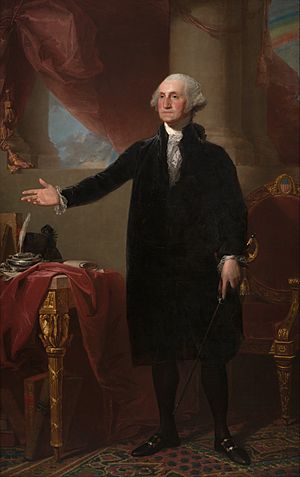
Here is a partial list of some of the well-known people Gilbert Stuart painted:
- Abigail Adams – The second First Lady of the United States.
- John Adams – The second President of the United States.
- John Quincy Adams – The sixth President of the United States.
- John Jacob Astor – America's first multi-millionaire, a fur trader, and art supporter.
- Commodore John Barry – Known as the "Father of the American Navy."
- Commodore Oliver Hazard Perry – A hero of the Battle of Lake Erie in 1814.
- Ann Willing Bingham – A well-known person in Philadelphia society.
- Hugh Henry Brackenridge – An early American writer and founder of the University of Pittsburgh.
- Rosalie Stier Calvert – A wealthy woman born in Belgium.
- John Singleton Copley – Another famous American portrait painter.
- Horatio Gates – A general in the American Revolutionary War.
- King George III – King of Great Britain and Ireland from 1760 to 1820.
- King George IV – King of Great Britain and Ireland from 1820 to 1830.
- John Jay – The first Chief Justice of the United States Supreme Court.
- Thomas Jefferson – The third President of the United States.
- Rufus King – One of the people who signed the United States Constitution.
- King Louis XVI – King of France from 1774 to 1792.
- James Madison – The fourth President of the United States.
- James Monroe – The fifth President of the United States.
- Joshua Reynolds – A famous English artist.
- John Trumbull – An artist during the American Revolutionary War.
- George Washington – The first President of the United States.
- Martha Washington – The first First Lady of the United States.
- Benjamin West – A well-known American painter.
- Catherine Brass Yates – A prominent person in Philadelphia society.
Portrait Gallery
-
American artist Benjamin West, 1783–84
-
English artist Joshua Reynolds, 1784
-
American artist John Singleton Copley, c. 1784
-
John Jones of Frankley, 1785, Birmingham Museum of Art
-
Mohawk leader Joseph Brant, 1785, British Museum, London
-
Robert R. Livingston, diplomat and Founding Father, 1793–94
-
John Jay, 1794, First Chief Justice of the United States Supreme Court
-
Sir Robert Kingsmill, Admiral in Royal Navy during American and French Revolutionary Wars
-
James Swan, 1795, Museum of Fine Arts, Boston
-
George Washington, 1795, Metropolitan Museum of Art New York City
-
George Washington (The Constable-Hamilton Portrait, 1797) Crystal Bridges Museum of American Art, Bentonville, Arkansas
-
George Gibbs, 1798, Newport Art Museum, Rhode Island
-
Anna Payne Cutts, sister of First Lady Dolley Madison, 1804, The White House
-
The fourth President of the United States, James Madison, 1804, Bowdoin College Museum of Art
-
Jérôme Bonaparte, brother of Napoleon Bonaparte, 1804
-
John Carroll, first Catholic bishop of the United States, c. 1804, Georgetown University Art Collection, Washington, D.C.
-
George Washington At Dorchester Heights, 1806, Boston Museum of Fine Arts
-
Mrs. Harrison Gray Otis, 1809, Reynolda House Museum of American Art, Winston-Salem, NC
-
The second First Lady of the United States, Abigail Adams, c. 1800–1815
-
Major-General Henry Dearborn 1812–1815[?]
-
American artist John Trumbull, c. 1818
-
The sixth First Lady of the United States, Louisa Catherine Adams c. 1821–1826, daughter-in law of John and Abigail Adams
-
The third President of the United States, Thomas Jefferson, c. 1821, National Gallery of Art, Washington, D.C.
-
The fifth President of the United States, James Monroe, c. 1820–1822
-
George Washington, 1825, one of Stuart's many copies of the Athenaeum Portrait, Walters Art Museum
See also
 In Spanish: Gilbert Stuart para niños
In Spanish: Gilbert Stuart para niños


